
Since today is the 75th Anniversary of D-Day, I was reminded not only of the role animation played in the second World War, but how the significance of historical events are often almost disattached from the films as the decades pass. They exist as a kind of residue of time, sort of like the package of a product that still exists with the actual contents long gone. In this way, it’s easy to view the films with only a precursory lens, as if they were describing things that exist as an idea now rather than reality.
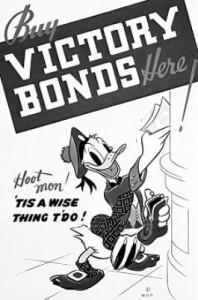 When we talk about films being dated, We’re usually referring to things that either have changed culturally or events that have less significance. There is almost no better example than the cartoons made during the war. It would be easy to view the animation material created during WW2 without much further need for analysis, taking the topical references at face value. In many ways, the entertainment animation created during the war *very purposely* understated the true significance and reality of the things they were often poking fun at; to do otherwise would be a reminder of the devastating consequences of the true world events at the time rather than a momentary escape.
When we talk about films being dated, We’re usually referring to things that either have changed culturally or events that have less significance. There is almost no better example than the cartoons made during the war. It would be easy to view the animation material created during WW2 without much further need for analysis, taking the topical references at face value. In many ways, the entertainment animation created during the war *very purposely* understated the true significance and reality of the things they were often poking fun at; to do otherwise would be a reminder of the devastating consequences of the true world events at the time rather than a momentary escape.
The generations that were directly involved in the fighting in World War 2 war are almost all gone at this point. I’m sure many of you reading this have relatives that were in the war, and that many of you remember it growing up either during or post-war. In some ways I feel that the animated films, very much by accident, betray the true nature of the horror of war since they were never made to be a representation of it, but rather a break from the events of the time mostly, even as they reflected the current conditions and experiences. Their presence is a much easier view than the history they represent.
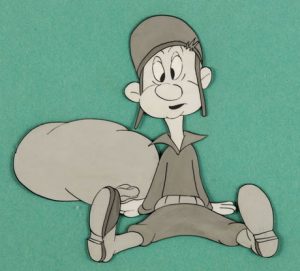 In researching the animated films at the United States National Archive, I was struck by how there seemed to be more material there about World War 2 than any other thing. There were many researchers there *every* time I went; for many it was their job; others, like myself, were researching a particular thing for a particular reason. What I was amazed at is how many people knew the actual films really well. I think at some point a lot of people were working for shows on the History Channel, and because of that the war material was well trodden.
In researching the animated films at the United States National Archive, I was struck by how there seemed to be more material there about World War 2 than any other thing. There were many researchers there *every* time I went; for many it was their job; others, like myself, were researching a particular thing for a particular reason. What I was amazed at is how many people knew the actual films really well. I think at some point a lot of people were working for shows on the History Channel, and because of that the war material was well trodden.
I can only imagine how many of the troops landing on D-Day had seen the Private Snafu animation created for them, and wonder what gave these brave people comfort in some of the most dire circumstances. I do hope the little films did help in some way as they seem to have. In this way, I think it’s worth celebrating and enjoying these films.
There are little indications of the impact of the shorts scattered through photos and names of aircraft, especially. There are some direct indications of the enjoyment of the Snafu character. Here are a few pages of reviews of the Army/Navy Screen Magazine Issues, noting Snafu’s popularity with the troops:
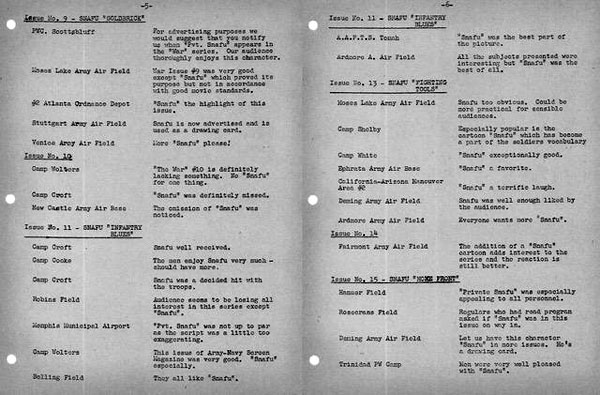
The ‘Snafu Special’, a Douglas C-47 Skytrain plane, was flown during D-Day. In some ways, the actual acronym , in my mind, is an amazingly accurate for the state of any war. In some way, perhaps Private Snafu was an inspiration of sorts on that day, at least in the naming.
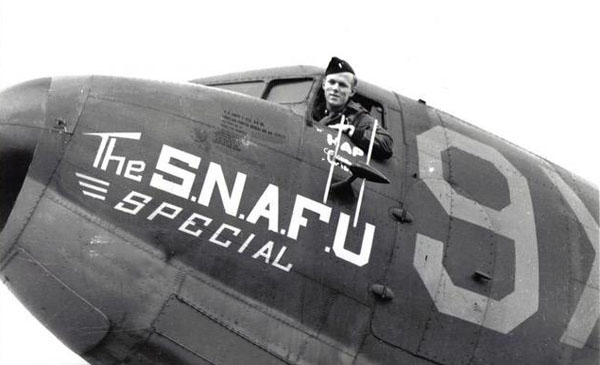
Snafu was featured in the Army’s ‘Yank’ Magazine at least a handful of times. Here’s a Christmas Cover, featuring wonderful figures by Ray Harryhausen:
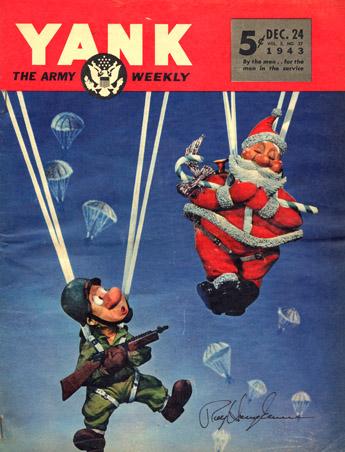
Here’s another, unpublished model made for Yank, based of course of ‘Malaria Mike’:
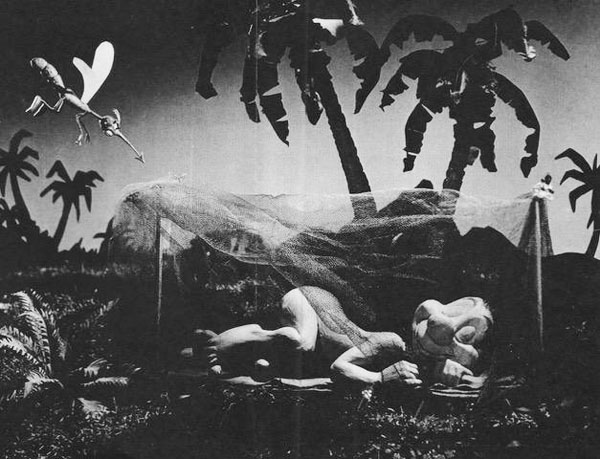
One of the interesting things I found when looking for Snafu references was the logo for the 2nd Emergency Squadron. This squadron was nicknamed ‘Snafu Snatchers’ and featured a logo of Snafu floating on a raft waiting to be rescued.
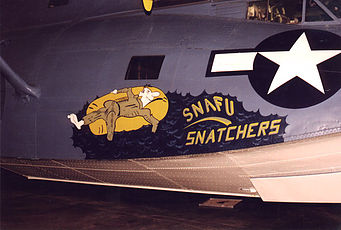
Here’s a nice little article that explains the squadron’s mission a little more.
Popeye, of course, is my favorite character; growing up I was really puzzled by the World War two short that were part of the package of cartoons shown on channel 50 in Detroit. I really like this little documentary produced for the third Popeye DVD volume. It does a really nice job of summarizing the role Popeye played in the cartoons of that time. I was happy to have a small role in this one as well, along with some true greats.
Finally, here’s a segment of footage we found at the National Archives featuring some pretty cool footage of the First Motion Picture Unit, along with some shots of Ray’s models (including the unused one above). I wonder if any of this footage really was ever used in anything- I couldn’t find it if it was.
Have a great week everyone, and thank you, Vets, for all you have done.


 Steve Stanchfield is an animator, educator and film archivist. He runs Thunderbean Animation, an animation studio in Ann Arbor, Michigan and has compiled over a dozen archival animation DVD collections devoted to such subjects at Private Snafu, The Little King and the infamous Cubby Bear. Steve is also a professor at the College for Creative Studies in Detroit.
Steve Stanchfield is an animator, educator and film archivist. He runs Thunderbean Animation, an animation studio in Ann Arbor, Michigan and has compiled over a dozen archival animation DVD collections devoted to such subjects at Private Snafu, The Little King and the infamous Cubby Bear. Steve is also a professor at the College for Creative Studies in Detroit.






















The character on the raft in the “Snafu Snatchers” logo looks more like Sad Sack than Snafu to me.
Did the animators really wore their uniforms to work? I feel like that footage was staged for a newsreel rather than being shot candidly.
I liked the “MAKING SNAFU CARTOONS video for those terrific Carl Stalling music cues. In fact, that entire disk is among my favorites of those that you’ve thus far produced from Thunderbean.
Fondly recall the WKBD CH50 Popeye package as well as the earlier Captain Jolly /Poopdeck Paul era on CKLW CH9, which seemed to be a mix of the old Famous Studios work, mixed with the newer KFS television shorts, with the occasional Fleischer, SINBAD or ALADDIN, thrown in…..do remember the white uniform a lot but not so much the full blown war stories….
That’s Dr. Seuss (Ted Geisel) at the desk in the lower left corner of the screen in the opening shot.
Going by the production numbers, the Fleischers rushed “The Mighty Navy” through production, to the point it made it into theaters three weeks prior to Pearl Harbor (it ended up as the first released cartoon for Seymour Kneitel following his return from a heart attack, but not the first put into production under his direction).
I do remember lots of WWII cartoon references as a kid, and being vaguely aware there was a war with Hitler, Nazis, and Japanese as the Bad Guys (a lot of friends, classmates and neighbors were Asian-American, so I at least understood it had evidently blown over). It was only much later in history class I actually got any context. The longtime puzzle was Russians. When I was growing up they were the dreaded commies; in the cartoons they were dancing cossacks or bearded anarchists dispensing big round bombs.
That Snafu Snatchers looks more like Sad Sack.
Very happy that two Thunderbeans arrived this week, Kipling’s Women and the long-awaited ScreenSongs. We keyed up the latter and my Friday night film party gang sang along to “Man on the Flying Trapeze” (and the cartoon looked GREAT) and a good time was had by all.
That is awesome. The whole point of having these available is that very thing; it makes me so happy to hear that they’re being enjoyed. None of this would be possible with all the wonderful collectors that have lent so many cool things. Thank Paul Mular for that one!